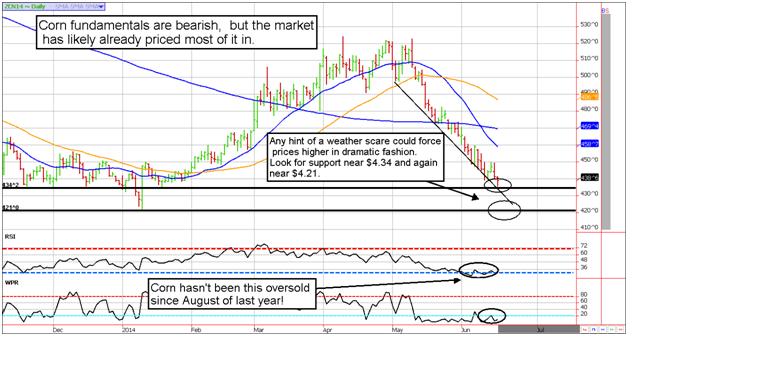Each individual locale has a relatively unique planting and harvest cycle; further, crops around the world face various windows of opportunity for the optimal growing season. Nevertheless, as a U.S. based commodity trader, the focus should primarily be on the domestic crop cycles because it is these that will have the largest impact on the Chicago Board of Trade corn futures contract. Additionally, U.S. corn production accounts for between 35 to 40% of world production, making the U.S. crop critical to global supply and demand fundamentals. These annual planting and harvest cycles, produce recognizable price patterns in the futures markets that might be useful to speculators.
As mentioned, the exact growing cycle is dependent on local climate and weather but in general U.S. corn producers plant their crops in early April through mid-June. In a normal year (if such a thing exists), corn futures prices tend to peak in June as planting is completed and uncertainty regarding the quantity of planted acres begins to dissipate. However, in a perfect weather and circumstances year, such as 2014, the corn market can trade counter to seasonal tendencies.
In mid-June of this year, we saw a scenario in which all of the bearish news was accounted for in price but none, or little, of the potential bullish factors had been considered. In other words, traders spent May and much of June selling corn on news of ideal planting weather, a bumper crop in the ground, and subsequent moisture to aid the growth of the planted seeds. Simply, at the time of this writing, the market was pricing in what is essentially a best case scenario for this year’s harvest yield.
We all know that a lot of can happen between July and harvest which is typically in October and November. In fact, it won’t take much for speculators to begin thinking in the opposite manner. Through mid-June they were trading on the premise of farmers successfully harvesting one of the largest crops in history; but news of hot, dry, or other weather ailments could quickly convert the bears into bulls who are eager to buy corn in anticipation of a potential heat wave or even drought. This is known as a weather market, or weather scare rally, and it surfaces nearly every year.
Officially, the typical mid-summer rally in corn isn’t due until August but that is based on a more “normal” year. Given that corn prices are at a trough going into late June, rather than the typical peak, it seems logical to look for a possible low much earlier in the cycle than is generally seen. Thus, we believe traders should begin looking for the move sooner rather than later. Also, we noticed that data isolated to the previous five years suggest the mid-summer rally has actually been an early-summer rally as of late. Specifically, in the last five years the market has turned from bearish to bullish in early July (this contradicts the 20 year stats that propose the seasonal low normally occurs in August).
On June 18, September corn was hovering near $4.40. In light of our seasonal analysis, and the fact that prices are in the “basement”, we can’t help but feel like the best trade will eventually be from the long side. Because Mother Nature is unpredictable, it is impossible to know exactly where the low might be, but this environment might make for an attractive scale trade. For most speculators, this might mean using the mini contracts to dollar cost average on the way down. Well-funded accounts willing to get aggressive might opt for the full-sized contract. Trend-line support lies near $4.34, but a move into the low $4.20s is certainly possible. If the summer growing season continues to be ideal, it might even be possible for a quick dip below $4.00. Nevertheless, in the end, nature almost always has its fun with grain market bears; accordingly, we believe bulls are best served nibbling on bullish trades into the decline.

*There is substantial risk in trading options and futures. It is not suitable for everyone.
Carley Garner is the Senior Strategist for DeCarley Trading, a division of Zaner, where she also works as a broker. She authors widely distributed e-newsletters; for your free subscription visit www.DeCarleyTrading.com. Her books, “A Trader’s First Book on Commodities,” “Currency Trading in the FOREX and Futures Markets,” and “Commodity Options,” were published by FT Press.
Related Reading
Dollar Index: The ETF Of The Futures Markets by Carley Garner




